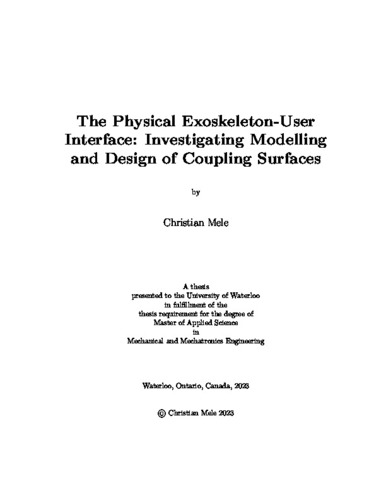| dc.contributor.author | Mele, Christian | |
| dc.date.accessioned | 2023-07-27 15:19:00 (GMT) | |
| dc.date.available | 2023-11-25 05:50:06 (GMT) | |
| dc.date.issued | 2023-07-27 | |
| dc.date.submitted | 2023-07-21 | |
| dc.identifier.uri | http://hdl.handle.net/10012/19635 | |
| dc.description.abstract | The goal of Lower Limb Rehabilitation Exoskeletons is to provide active and passive support to the user for rehabilitation goals focused on the restoration of function and independence to the user. In circumstances where rehabilitation is not possible, many of these devices can be utilised as fully assistive wearables. The target populations for these devices vary, but often include individuals with varying degrees of mobility impairment. A critical component that defines and governs the relationship between user and device, and often remains ignored in study, is the exoskeleton coupling interface. The interface imparts forces to the user, and as a result, directly influences the safety and performance of the exoskeleton. An optimized balance between user safety and performance must be met. This thesis is focused on and motivated by assistive rehabilitation robotics, with many of the concepts introduced here extending to wearable interfaces.
Injury risks include interaction forces creating joint misalignments that cause undesirable loading and high, prolonged surface pressures. The current tools for evaluation, sensors and models, are adequate at estimating the basic components of user safety but do not readily inform design for newer exoskeleton coupling surfaces. This is a result of a lack of standardisation and transferability in analysis. Lack of baselines, difficult to utilise metrics, relatively simple models, and inadequate methods for evaluation currently limit evaluation and innovation of new exoskeleton coupling interfaces.
The focus of this thesis is to build upon the groundwork laid by prior academic research to identify the drawbacks of existing exoskeleton coupling surfaces, and to improve upon them. This is done by investigating the most commonly approached and evaluated subtopics of exoskeleton coupling design: 1) iterative and sensor based design processes and 2) modelling based evaluation. To improve upon the sensor based processes, a highly customised fully conforming surface inspired by orthoses and prostheses design was developed to introduce new baselines for coupling interface design as a “best case scenario” supported by pressure and joint misalignment related metrics. Modelling of the exoskeleton coupling surface was investigated by first evaluating commonly used models, then developing two novel models with the express intent of addressing initial strapping conditions and estimating pressure conditions prior to manufacturing. The second of these two models, based on elastic foundations, indicated that strapping conditions could be estimated within 10\% accuracy of real conditions without a manufactured surface.
Contributions to both of these subtopics made in this thesis were with the goal of developing better standards and transferability of information in mind. With these tools, better comparison of the exoskeleton coupling interface can be accomplished that is informed by established baselines, models, metrics and methods for evaluation. | en |
| dc.language.iso | en | en |
| dc.publisher | University of Waterloo | en |
| dc.subject | exoskeletons | en |
| dc.subject | physical human robot interface | en |
| dc.subject | coupling interface | en |
| dc.subject | mannequins | en |
| dc.subject | skin injury | en |
| dc.subject | wearables | en |
| dc.subject | lower limb exoskeletons | en |
| dc.subject | exos | en |
| dc.subject | robotics | en |
| dc.subject | contact mechanics | en |
| dc.subject | soft materials | en |
| dc.subject | rehabilitation engineering | en |
| dc.subject | rehabilitation robotics | en |
| dc.subject | gait | en |
| dc.subject | contact surface evaluation | en |
| dc.subject | pressure interfaces | en |
| dc.subject | pressure maps | en |
| dc.subject | physical interface design | en |
| dc.subject | H3 exoskeleton | en |
| dc.subject | exoskeleton coupling interfaces | en |
| dc.subject | multi body systems | en |
| dc.subject | capstan equations | en |
| dc.subject | exoskeleton testbenches | en |
| dc.subject | wearables usability evaluation | en |
| dc.title | The Physical Exoskeleton-User Interface: Investigating Modelling and Design of Coupling Surfaces | en |
| dc.type | Master Thesis | en |
| dc.pending | false | |
| uws-etd.degree.department | Mechanical and Mechatronics Engineering | en |
| uws-etd.degree.discipline | Mechanical Engineering | en |
| uws-etd.degree.grantor | University of Waterloo | en |
| uws-etd.degree | Master of Applied Science | en |
| uws-etd.embargo.terms | 4 months | en |
| uws.contributor.advisor | Tung, James | |
| uws.contributor.advisor | Mombaur, Katja | |
| uws.contributor.affiliation1 | Faculty of Engineering | en |
| uws.published.city | Waterloo | en |
| uws.published.country | Canada | en |
| uws.published.province | Ontario | en |
| uws.typeOfResource | Text | en |
| uws.peerReviewStatus | Unreviewed | en |
| uws.scholarLevel | Graduate | en |

